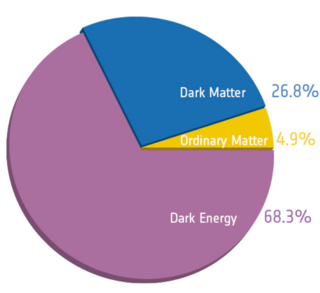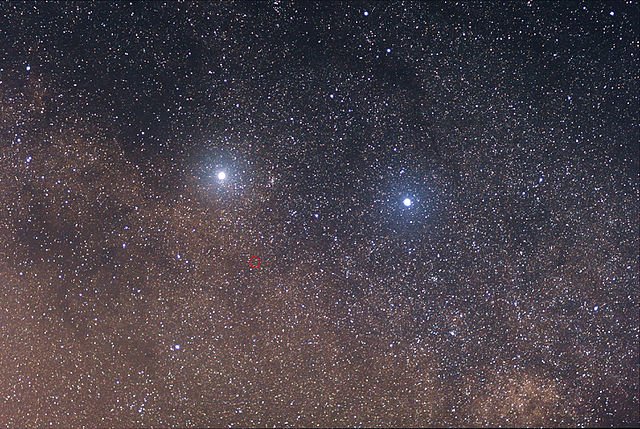Is standard cosmology challenged by the structure of the galaxies?
One of my favorite sport on Steem is to write physics posts about what Steemians are questioning themselves about, or find interesting.
Along these lines, my attention has been recently brought to this research article, that has been published in Science.

[image credits: Wikipedia]
Just for the record, I don’t like Science much: not an open access journal…
This article discusses the organization of satellite galaxies around larger galaxies (like ours).
It demonstrates how the way in which satellite galaxies move around the larger ones is challenging standard cosmology.
THE PECULIARITY OF ANDROMEDA AND THE MILKY WAY
Our galaxy, the Milky Way, is surrounded by a bunch of satellite dwarf galaxies rotating around it, and all mostly located within a single plane. This is not new and actually known since the 1970s (see here). For instance, the Magellanic clouds are the most known examples of such dwarf galaxies, as they are visible with naked eyes.

[image credits: Wikipedia]
But is this a special feature of our galaxy?
Since about 10 years, we also know that the Andromeda galaxy features the exact same thing: it is surrounded by a bunch of dwarf galaxies, all located within a single plane.
But why is this important?
Because this structure, in which dwarf galaxies are located in a plane around a more massive galaxy, is very complicated to predict using standard cosmology.
The latter indeed predicts that dwarf galaxies are in general spread isotropically (i.e. equally in all directions) around larger galaxies.
One easy way to go around this issue is to claim that the local group, i.e. the group of galaxies containing the Milky Way and Andromeda, is special. In other words, what we have observed with Andromeda and the Milky Way consists of rare exceptions in our successful standard cosmological model.
This is where our article comes into the game. But before discussing this further, let us focus a little bit on standard cosmology.
STANDARD COSMOLOGY IN A NUTSHELL
The standard model of cosmology, that is also called the Lambda Cold Dark Matter or the ΛCDM model, is a model relying on the Big Bang hypothesis to explain how our universe works.
This model is the most minimal and simplest model that explains a plethora of properties of the universe. This includes in particular the cosmic microwave background (see for instance this post of mine), the large scale structures in the universe (see here), the light element abundance in the universe (see for instance this post of mine) and the accelerating expansion of our universe (see for instance this post of mine).

[image credits: ESA]
The ΛCDM model assumes that the universe is mostly flat, i.e. that it consists in a flat surface deformed by the objects that lie on it.
By flat, I here mean that if we draw two parallel lines (or send two laser beams) in a given direction, they will never cross.
The Lambda in ΛCDM refers to the cosmological constant. This represents dark energy, the stuff that is responsible for the accelerating expansion of the universe. As shown in the pie above, the cosmological constant is connected to almost 70% of the energy of the universe.
The second component in the energy pie of the universe concerns dark matter. It amounts to 27% of the energy budget of the universe, whose rest of it is made of visible matter (stars, galaxies and anything else).
Assuming the ΛCDM model, we can make simulations to see whether we recover the observed structures of the galaxies. And this is the intriguing fact: the satellite galaxies around the Milky Wy or Andromeda should be distributed isotropically, i.e. not all localized in a given plane.
THE CENTAURUS GROUP OF GALAXIES
In this article, the authors focus on a galaxy group located in a constellation named Centaurus, illustrated in the image below.

[image credits: Wikipedia]
For those who have heard about Proxima Centauri, the closest star to Earth after the Sun, the Centaurus constellation consists in the group of galaxies containing that star.
This group of galaxies is one of the largest cluster of galaxies close to us (but outside the local group).
It contains two subclusters: the Cen A group located around the Centaurus A galaxy, and the M83 group centered on the M83 galaxy. Yeah, great namess :p
In the considered article, the authors investigate the distributions of the galaxies around Cen A, that were earlier claimed to be distributed within two planes (and not one). However, recent observations have exhibited the presence of much more galaxies than we thought, so that their global distribution now matches better a single-planar structure, as for the Milky Way and Andromeda.
The researchers have investigated this single-planar structure and try to see, within the ΛCDM model, how it could be predicted around the three galaxies Cen A, the Milky Way and Andromeda. There are ways, but the likelihood it works is below 0.5%.
FINAL DISCUSSION
In this post, I have discussed a recent research article in which the distribution of satellite dwarf galaxies around the Milky Way, Andromeda and Cen A is studied in the context of standard cosmology. For all three cases, the satellite galaxies are organized along a single-plane, which is very unlikely to occur in standard cosmology.
For this reason, the observations now challenge standard cosmology, although the latter works extremely well for many other features of our universe. Some new puzzles to which we will hopefully get a better clue in the future…
If you also have good physics questions, dont hesitate to bug me on the steemSTEM discord server. I will be more than happy to discuss this with you!
SteemSTEM is a community-driven project that now runs on Steemit for more than a year. We seek to build a community of science lovers on Steemit and to promote well written/informative Science Technology Engineering and Mathematics (STEM) postings in order to make Steemit a place for fascinating STEM content.
More information can be found on the @steemstem blog, on our discord server and in our last project report.
Hi, I found some acronyms/abbreviations in this post. This is how they expand:
Ahaha. Again in the images...You won't get me twice ;)
;)
Lol! Epic!
Isn't it? :D
Hey @lemouth, nice read.
I think that the accelerating expansion of the Universe is proof that all matter in the Universe was once massed in a point of infinite density. Sounds like evidence supporting the big bang theory.
Furthermore, could gravity be the reason we can't actually observe dark matter? Or maybe should we start looking at different wavelengths of the electromagnetic spectrum?
I'd love to know your thoughts!
There are plenty of evidence supporting standard cosmology. However, other options are still very alive.
Dark matter is by definition not electromagnetically interacting. So no, the EM spectrum won't help here. The gamma ray spectrum could in contrast be helpful (dark matter annihilation produces cosmic rays that we can detect).
Dark matter can be many things, and not all options are currently covered by the direct detection experiments. They will however probably be in a decade or two. So that we just have to be patient. For the moment, all pieces of evidence are indirect. We are missing the direct observation.
And again, other non-dark-matter options are still alive, although not as appealing...
I greatly appreciate your detailed response.
I get it that we can basically observe the effects of the presence of dark matter and therefore realize it actually exists even though we can't collect direct pieces of evidence, however I find it rather confusing how matter can actually not interact with electromagnetic radiation at all. That basically means no radiation is absorbed nor reflected whatsoever.
There must be some fundamental differences between ordinary and dark matter in terms of frequency and vibration. I'm no expert though, just speaking my thoughts!
Thanks for the information!
Any electrically neutral particle does not interact electromagnetically. Take the neutrino for instance.
This I am not sure to understand what you mean. I would need clarifications.
That's really cool. I had never heard about that challenge to the standard model though I've heard quite a couple now. I can't wait to see how all of those will be resolved if this happen in my lifetime.
As always, the problem is that on the one hand we have a theory that works extremely well, but on the other hand we have issues. Since the theory works well, we do not want to throw it too quickly to the bin. However, the issues are really puzzling.
Hopefully the future will bring us more insights :)
Sound's like the model just need's to be tweaked a little. When I looked at the original paper they do suggest that galaxy collisions and the subsequent tidal stream that forms could condense into dwarf galaxies which would indeed likely be in the same plane.
Yes, this suggests that the current paradigm must be optimized a little bit. But how? :D
That 's out of my area I'm afraid, but I do know somebody that specializes in the study of tidal streams from galaxies. I might post him a message about that article to see if he has any thoughts about this.
By 'but how', I was actually meaning this opens a field of research. You don't need to provide me an answer :)
Ah yes, I misinterpreted that :)
great post. The earth is spherical in a flat universe. how did scientist come up with the notion that our universe is flat ?
The definition of flatness is what matters. In this case, a cylinder is flat, for instance. Data shows that the universe is flat, by the way.
This comes across like astronomy.
It's a really abstract aspect of science.
Abstract? But we have observations! This is not what I would call abstract.
I find the study of Cosmology fascinating. I feel that the current model is cumbersome, I would like some day to to dig deep into some of my questions.
I am curious about the nature of red shift as we think. I say this because there are examples of quasars with high redshift connected by a plasma filamento to a galaxy of much lower red shift, suggesting a plasma filament stretching 100's millions of light years. Ofcourse red shift is the holy grail of Astronomy and as an Astrophysicist I must repeat the known theory. But from what I have come across it's quite credible.
Anyway thanks for your post. Galaxy dynamics are crazy, it still baffles me how some galaxies have pretty perfect structure considering the number of full orbits some stars made during the galaxies existence.
Cheers @lemouth
Red shift is just an example of Doppler effect. I am not sure to follow your comment... You need to be clearer here ;)
Maybe the comment was quite obscure. Yes the Red shift is an example of the Doppler effect, and with the value of Redsift we can estimate the age and it's distance based on Hubble's Law. I forgot the scientist who saw this but what he noticed was images of galaxies with low redshift meaning they are close and a quasar with high redsihft which means it's far away, but they were connected by a filament of material. It would have meant that the filament was millions of light years long to stretch from the galaxy to the quasar.
An astronomer called William Tifft came up with the idea of Red-shift Quantisation, this leads me to entertain the idea of energy levels of galaxies like those of the atom. I know it's reaching far, but I've looked into it physically and thought about it philosophically, it's quite possible. Maybe one day when I have time i'd like to try to look into it deeper. But for now priorities call.
This idea does not seem to work according to current data....
@lemouth is right, this is true. The accepted consensus on this issue is that Red shift is not quantized, so anyone studying this subject should also learn and embrace the main stream view. This is a very important point!
Sometimes scientists develop alternative theories, some are way off the mark, others may good arguments, and some discover something new. As scientists we should work from accepted theories of our peers, but it's healthy to consider other theories and see what they can teach us if anything.
The consensus is supported by data. Alternative theories are good, as long as data is not telling us they are wrong or barely realistic.
Interesting
This idea is not really mainstream today. The largest fraction of the community rejects it in the light of data.
My favorite sport is meme. Looking forward to becoming the most badass meme debater in the whole multiverse.
Things that seriously interest me are as follows:
Ahaha, I forgot to be more precise: anything about particle physics, astrophysics of cosmology. Sorry to disappoint you ;)
It's fine bro. I am a generalist type of person, so to speak. Too many brilliant people have been into this field, scrutinizing the very minuscule details on the fabric of the cosmos. Adding my own share of ignorance would not make any sense to the vast collection of scientific papers written everyday. I was just trying to paint a big picture on the nature of reality using science and rational and irrational experience alike. Science for me is just a tool by which we can build a somehow 'objective' foundation of whatever justification we assign on this vague notion of existence.
The idea that this reality as we experience it might be just a shared hallucination is playing in my mind every so often. The more I delve deeper, the more I get inclined to the nihilistic point of view. In the words of Ernest Hemingway:
On the other hand, trying to understand nature is really really funny and interesting :)
Terrific article, love astronomy. Imagine all the future discoveries of how everything in the universe and beyond follows patterns and undiscovered laws of physics. So excited for the future. See you on the moon! Meow mRrrrrrrrrr...
Naah, I won't go to the moon. I prefer to stay on Earth on do science from here :D
The study is quite deep. Thank you @lemouth for sharing our knowledge.
my pleasure.